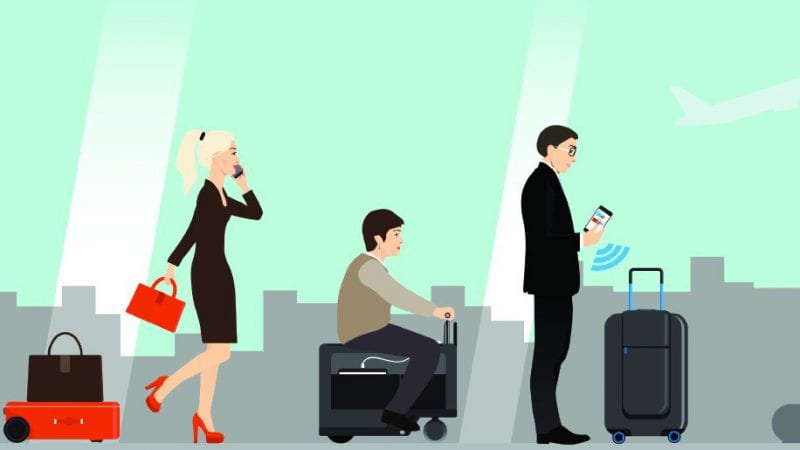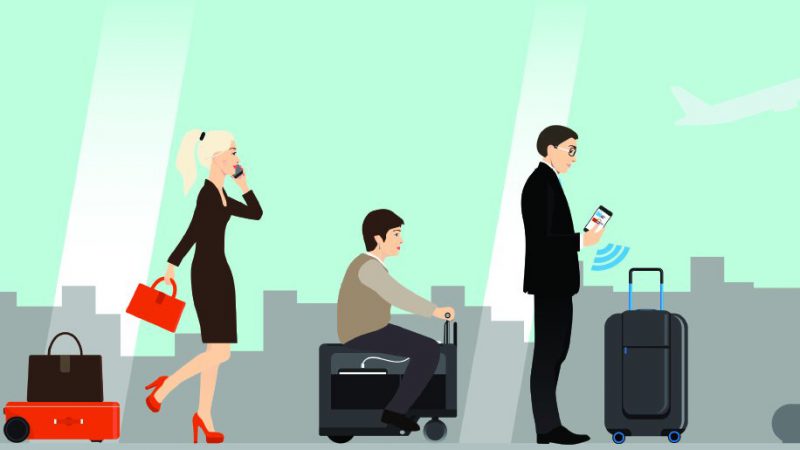Batteries Not Included
Smart luggage is the latest thing in carryon kit. These nifty bags come with features like built-in phone chargers, remote controlled locks and GPS tracking. They also come with batteries – which can be a headache at check-in unless you know the rules
March 30, 2019

Frankly, much of what we take for granted in modern travel – and indeed, in modern life – would not be possible without good ol’ Number 3 on the periodic table: Lithium. More specifically, lithium-ion batteries, those compact, lightweight heavyweights of the energy storage business.
Lithium-ion batteries are the power source in everything from green cars and digital cameras to our laptops and cell phones. The most recent applications are being found in so-called ‘smart bags,’ high-tech luggage that performs myriad duties from charging your mobile devices to connecting them via its own WiFi hotspot. Other features include tracking the bag with GPS, controlling the bag’s TSA locks from your smartphone and weighing the bag just by picking it up. Some motorized bags will even follow you around the airport like a loyal puppy.
However all this convenience comes with a caveat: Lithium-ion batteries have a checkered past. The batteries have been known to overheat and catch fire, sometimes with catastrophic consequences. To begin with, the lithium is highly reactive and the battery itself is under pressure so if the battery is damaged, a fire can result. The other possibility is something called thermal runaway, where the internal heat of the battery can build up and cause an explosion.
While such accidents are rare, they can be hazardous, so the international bodies that govern aviation like the International Air Transportation Association and the International Civil Aeronautics Organization have recommended that lithium-ion batteries be banned from aircraft cargo bays. Instead carriers are requiring that the batteries be removed from smart bags before they’re checked and carried with the passenger in carryon luggage. Some carriers even require batteries to be removed from smart bags before the bags can be used as carryons. The thinking is that cabin crews can respond to a fire in the passenger compartment much more quickly than if an incident starts out of sight in the cargo hold.
All Things Considered
Airlines have had the ban on checking smart bags in place for over a year, and most frequent fliers are aware of the prohibition. But if you don’t own a smart bag and are shopping around for one, there are a couple of things to consider. First, there is a power limit. The battery can be no more than 100 watt-hours (Wh) for lithium-ion and 2 grams of lithium metal for lithium metal, according to IATA. “These limits are no different to previous limits established for carrying batteries,” the IATA statement reads.
Next, assuming you want to be able to check the bag, you must be able to remove the battery. However “removable” does not always equate to “quickly and conveniently removable.” Some luggage manufacturers who tout their removable batteries tuck the battery compartment away, making it difficult to retrieve from a packed bag. Others actually come with their own TSA-approved screwdriver to open the battery case.
The best bet is to choose a smart bag with a battery compartment that’s both accessible and easy to open. Away is one manufacturer that’s designed its carryon with a top-loading ejectable power supply. The bag’s polycarbonate shell is lightweight and the TSA locks are built in. Away carryon bags start at $225 and come with a 10,000 mAh battery pack.
Arlo Skye is another line of smart luggage that boasts a “removable portable charger with built-in surge and short-circuit protection.” The 10,050 mAh battery pops out at the touch of a button, a design intended to make it easy for travelers to keep the power supply with them. The bags are stylish but pricey, starting at $450 for the polycarbonate body; it’s also available in an aluminum-magnesium shell. No zippers here; the combination latches are TSA-compliant
Other smart bag manufacturers, such as Heys, avoid the lithium question altogether by loading their luggage with triple A batteries. The batteries are not rechargeable and there’s no auxiliary port to charge your other devices, but that’s offset by the fact that they don’t have to be removed from the case before checking. However they do have features like baggage tracking, remote control locks and even proximity alarms.
Finally, even though the rules have been around for a while, if you’re unsure whether you can check your bag, the smart thing to do is check with the airlines you’re traveling with – all of them, if you’re transferring carriers. Here you’ll find rules for both checked and carry-on luggage.




